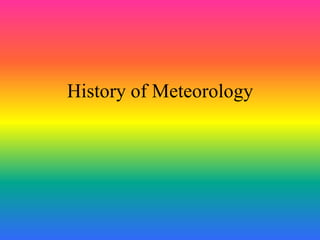History Of Meteorology
•Download as PPTX, PDF•
0 likes•257 views
Meteorology is the study of the atmosphere and weather phenomena. Aristotle wrote one of the earliest works on meteorology in 340 BC called "Meteorologica" which described the science of the earth's geology, elements, hydrology, winds, and weather. Key early weather instruments included the water thermometer in the 1500s, the mercury barometer invented in 1643 to measure atmospheric pressure, and the anemometer created in 1667 to measure wind speed. These inventions helped advance understanding of the atmosphere and forecasting of weather events like hurricanes and thunderstorms.
Report
Share
Report
Share

More Related Content
What's hot (11)
Similar to History Of Meteorology
Similar to History Of Meteorology (20)
History Of Meteorology
- 7. An anemometer is a device for measuring wind speed, and is a common weather station instrument. The term is derived from the Greek word anemos, meaning wind. The first known description of an anemometer was given by Leon Battista Alberti around 1450[1].
